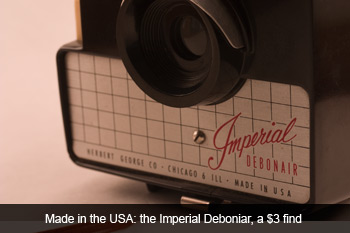Recently, Mike over at The Online Photographer ran a challenge to readers called “Befriend-A-Forgotten-Camera”, which is just what it sounds like. Go out, find an old camera, take a shot or three, and send one in. This of course peaked my interest given that Monica and I have been in the befriend a forgotten camera business for a while. I commented on the story (it’s the feature comment, thanks Mike!) about how we see old cameras as a social gateway and what better time then now to extend that comment.

In the era where MySpace, SMS, and cell phone cameras rule the world, there is the often forgotten film camera at many a garage and estate sale. People often pass them by without much of a glance, some even pick them up and wonder what it does. The concept of film and non-automatic exposure is alien to most, and even at the cheapest of prices, most people simply pass.
Sometimes the opposite occurs and the camera is priced well above any chance of sale; the Polaroid Land camera is probably our most common find, and about half of the people selling do not want to hear that the camera they want $20 is worth maybe $2. We should know, we only have 15 at last count.
At all ends of the price scale, in places from basements to barns, you will often find an old camera. Monica and I look for the rare and unusual, but have no problem walking away with a $3 bakelite 620 film camera that nobody wants. The reason behind it stems from the social aspect of that old film camera.
While most people would pass at the opportunity to buy an old film camera, given the opportunity and the conditions, they are more than happy to take pictures with one. We’re found that if you hand someone an old camera, they act like it’s an antique and are almost afraid of it. While that may very well be the case, my philosophy is that it’s still a camera and it was made to take photographs. Age or not, lets have some fun with it.
On this thread, Monica and I started handing them to the cell phone camera addicted friends we had who had no concept of shooting film or manual cameras. We loaded up everything from twin lens reflex style 620 point and shoots to basic 120 box cameras. It doesn’t take much to opperate one of these cameras, simply press the button or pull the shutter switch, and roll to the next number. With no LCD to offer immediate satisfaction this experiment could have been the shortest attempt at getting the non-photographer interested in something old, manual, and forgotten.

Instead, something interesting happened: people got into the process and started to like that old film camera in their hands. People started telling us how much fun it was, and soon enough they were asking for more film on our outings. Some even wanted to process their own film, which was something we did not expect.
Given the response, we soon let people take the camera of their choice. Many of them cost us next to nothing, and any old camera in service is okay by us. We’ve given away everything from plastic 35mm toy cameras to SLR’s. If they want to develop the film at our place, we let them have at it. We let people experiment and play, and we all have fun together. It’s a great atmosphere to be around.
You could argue that the same social aspect exists with digital cameras, that the photo walks that many people organize is along the same idea and that places like Flickr or Photo.net allow people to freely exchange photography ideas. I find this to be very true, and I often use these places and events to see what creative outlets people are trying.
At the end of the day, the social aspect of old film cameras appeals to my sense of the then and now, the idea of preserving history and having fun doing it not by oneself, but with friends. I don’t get that feel with digital (yet). Every new old camera is another learning experience and another opportunity for that age old question at the park, “what kind of camera is that?”